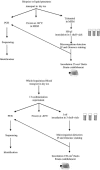Use of shell-vial cell culture assay for isolation of bacteria from clinical specimens: 13 years of experience
- PMID: 16207953
- PMCID: PMC1248519
- DOI: 10.1128/JCM.43.10.4993-5002.2005
Use of shell-vial cell culture assay for isolation of bacteria from clinical specimens: 13 years of experience
Abstract
The shell-vial culture assay is performed routinely in our laboratory. Recently we revisited our experience of using the shell-vial culture assay for the isolation of microorganisms from various clinical samples. Over a 13-year period, we have isolated 580 bacterial strains (5%) from 11,083 clinical samples tested. Over the same period, 285 isolates of rickettsiae, bartonellae, or Coxiella burnetii were cultured from a total of 7,102 samples tested. These isolates include 55 Rickettsia sp. isolates, 95 Coxiella burnetii isolates, and 135 Bartonella sp. isolates. Based on our experience with the growth of fastidious microorganisms, we have used a centrifugation shell-vial technique called JNSP, for "je ne sais pas" ("I don't know [what I am growing]") for the isolation of other microorganisms. A total of 173 isolates were cultured from the 3,861 clinical samples tested using the JNSP method. Of these, 40 isolates had not been grown before on usual axenic medium. These include 2 Staphylococcus aureus isolates, 7 isolates of Streptococcus sp. and related genera, 6 Mycobacterium sp. isolates, 1 Nocardia asteroides isolate, 1 Actinomyces sp. isolate, 1 Brucella melitensis isolate, 2 Francisella tularensis isolates, 1 Mycoplasma pneumoniae isolate, and 1 Legionella pneumophila isolate. Using this protocol, we have also cultured intracellular bacteria such as Chlamydia trachomatis and we have performed the first culture and establishment of Trophyrema whipplei. Applied in our laboratory, the shell-vial culture generally exhibits a low rate of success. However, in some cases, this technique allowed microbial diagnosis when classical agar procedure and PCR were negative.
Figures



Similar articles
-
[Anaerobiosis beyond anaerobic bacteria: its role in the recovery of aerobic microorganisms from purulent samples].Rev Argent Microbiol. 2010 Apr-Jun;42(2):102-7. doi: 10.1590/S0325-75412010000200007. Rev Argent Microbiol. 2010. PMID: 20589330 Spanish.
-
Comparison of three transport systems (Starplex StarSwab II, the new Copan Vi-Pak Amies Agar Gel collection and transport swabs, and BBL Port-A-Cul) for maintenance of anaerobic and fastidious aerobic organisms.J Clin Microbiol. 2001 Jan;39(1):377-80. doi: 10.1128/JCM.39.1.377-380.2001. J Clin Microbiol. 2001. PMID: 11136806 Free PMC article.
-
A quasi-universal medium to break the aerobic/anaerobic bacterial culture dichotomy in clinical microbiology.Clin Microbiol Infect. 2016 Jan;22(1):53-58. doi: 10.1016/j.cmi.2015.10.032. Epub 2015 Nov 11. Clin Microbiol Infect. 2016. PMID: 26577141
-
Current and past strategies for bacterial culture in clinical microbiology.Clin Microbiol Rev. 2015 Jan;28(1):208-36. doi: 10.1128/CMR.00110-14. Clin Microbiol Rev. 2015. PMID: 25567228 Free PMC article. Review.
-
The role of anaerobic bacteria in sinusitis.Anaerobe. 2006 Feb;12(1):5-12. doi: 10.1016/j.anaerobe.2005.08.002. Epub 2005 Oct 12. Anaerobe. 2006. PMID: 16701606 Review.
Cited by
-
Case Report: Scalp Eschar and Neck Lymphadenopathy Associated with Bacteremia due to Coxiella-Like Bacteria.Am J Trop Med Hyg. 2017 Nov;97(5):1319-1322. doi: 10.4269/ajtmh.17-0251. Epub 2017 Aug 18. Am J Trop Med Hyg. 2017. PMID: 28820698 Free PMC article.
-
Molecular strategy for the diagnosis of infectious lymphadenitis.Eur J Clin Microbiol Infect Dis. 2018 Jun;37(6):1179-1186. doi: 10.1007/s10096-018-3238-2. Epub 2018 Mar 29. Eur J Clin Microbiol Infect Dis. 2018. Retraction in: Eur J Clin Microbiol Infect Dis. 2025 Apr;44(4):1015. doi: 10.1007/s10096-025-05087-8. PMID: 29594802 Retracted.
-
Advantages and Limitations of 16S rRNA Next-Generation Sequencing for Pathogen Identification in the Diagnostic Microbiology Laboratory: Perspectives from a Middle-Income Country.Diagnostics (Basel). 2020 Oct 14;10(10):816. doi: 10.3390/diagnostics10100816. Diagnostics (Basel). 2020. PMID: 33066371 Free PMC article. Review.
-
Bartonella henselae in skin biopsy specimens of patients with cat-scratch disease.Emerg Infect Dis. 2010 Dec;16(12):1963-5. doi: 10.3201/eid1612.100647. Emerg Infect Dis. 2010. PMID: 21122232 Free PMC article.
-
Clinical diagnosis of Q fever by targeted next-generation sequencing for identification of Coxiella burnetii.BMC Infect Dis. 2025 Feb 7;25(1):190. doi: 10.1186/s12879-024-10437-6. BMC Infect Dis. 2025. PMID: 39920575 Free PMC article.
References
-
- Baisden, B. L., H. Lepidi, D. Raoult, P. Argani, J. H. Yardley, and J. S. Dumler. 2002. Diagnosis of Whipple disease by immunohistochemical analysis: a sensitive and specific method for the detection of Tropheryma whipplei (the Whipple bacillus) in paraffin-embedded tissue. Am. J. Clin. Pathol. 118:742-748. - PubMed
-
- Balwit, J. M., P. Van Langevelde, J. M. Vann, and R. A. Proctor. 1994. Gentamicin-resistant menadione and hemin auxotrophic Staphylococcus aureus persist within cultured endothelial cells. J. Infect. Dis. 170:1033-1037. - PubMed
-
- Beati, L., J. P. Finidori, and D. Raoult. 1993. First isolation of Rickettsia slovaca from Dermacentor marginatus in France. Am. J. Trop. Med. Hyg. 48:257-268. - PubMed
-
- Bentley, S. D., M. Maiwald, L. D. Murphy, M. J. Pallen, C. A. Yeats, L. G. Dover, H. T. Norbertczak, G. S. Besra, M. A. Quail, D. E. Harris, A. Von Herbay, A. Goble, S. Rutter, R. Squares, S. Squares, B. G. Barrell, J. Parkhill, and D. A. Relman. 2003. Sequencing and analysis of the genome of the Whipple's disease bacterium Tropheryma whipplei. Lancet 361:637-644. - PubMed
Publication types
MeSH terms
LinkOut - more resources
Full Text Sources
Medical

